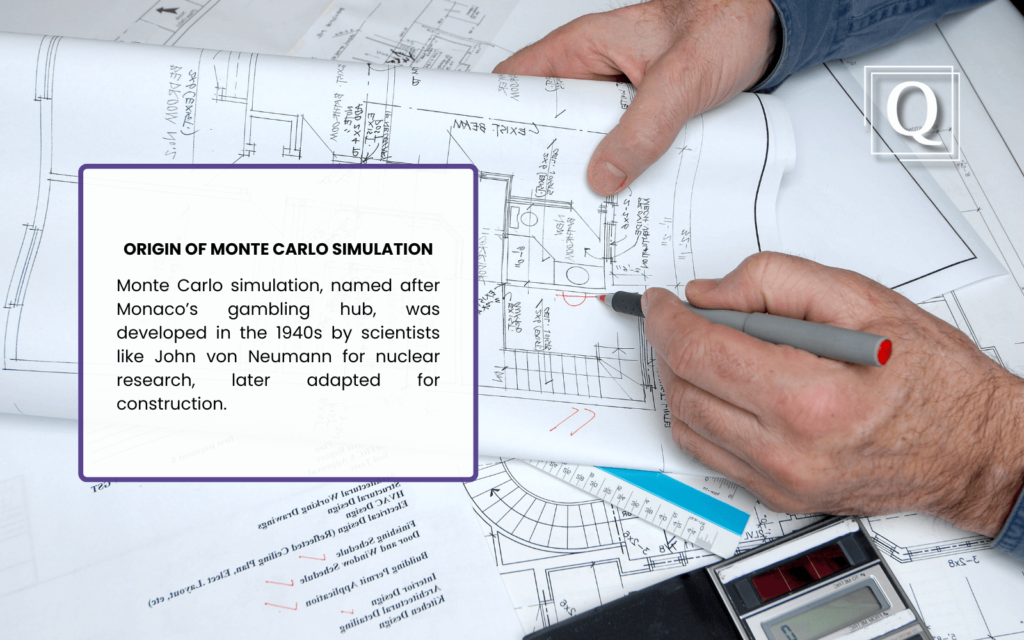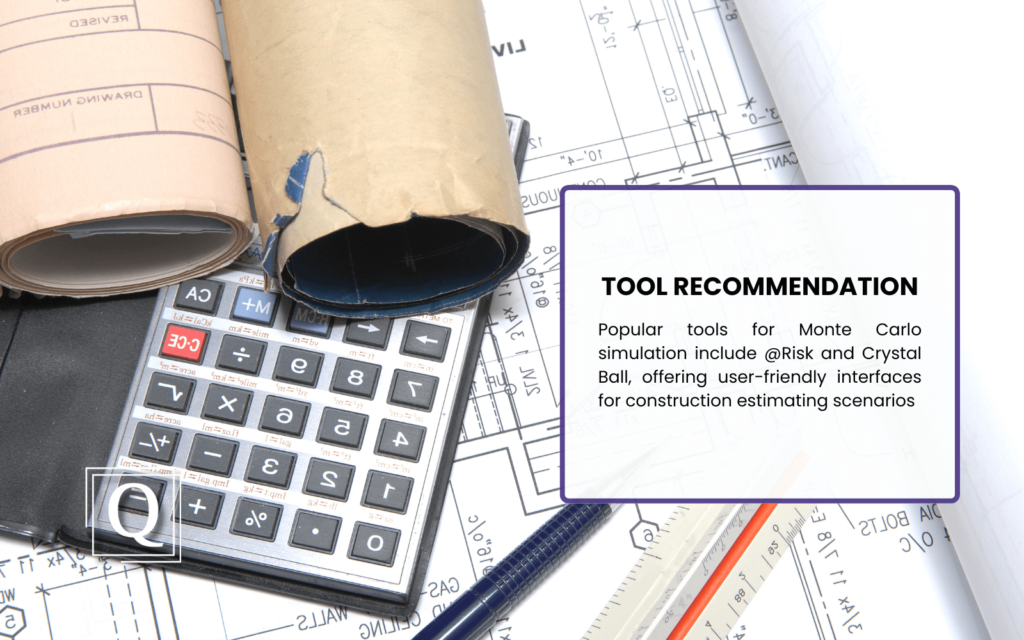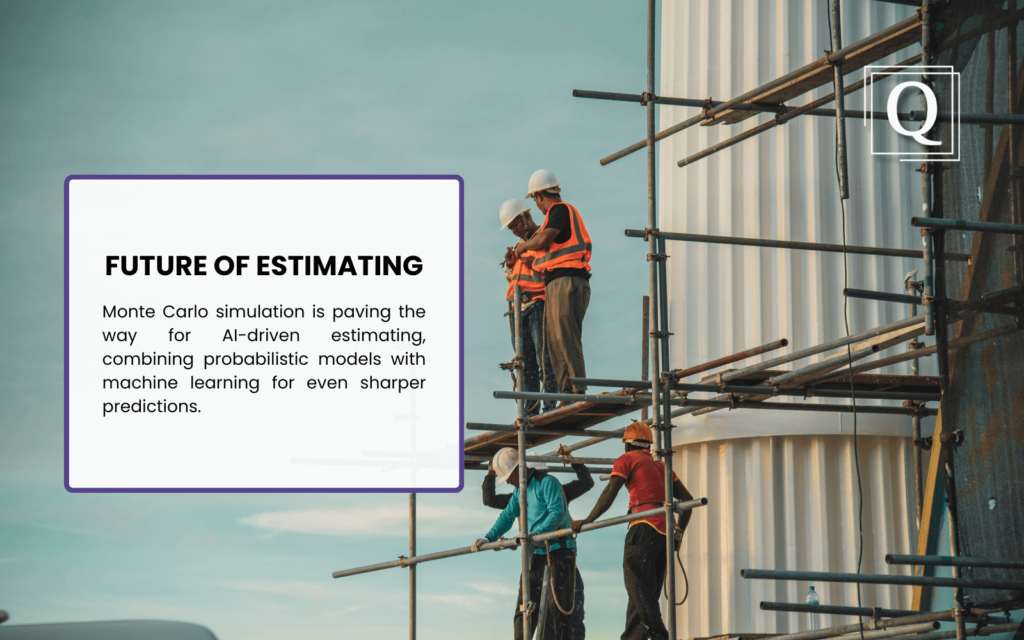Quick Article Overview:
- What Monte Carlo simulation is and its core principles
- How Monte Carlo simulation applies to construction estimating
- Key benefits for contractors and project managers
- Implementation steps for Monte Carlo simulation in construction projects
- Case studies and practical applications
- Comparison with other estimation methods
- Tools and resources for implementing the Monte Carlo simulation
Introduction:
Construction projects face constant challenges with accuracy in cost forecasting. Project managers know all too well that a single miscalculation can cascade into budget overruns, delayed timelines, and frustrated clients. The construction industry has long searched for better ways to predict costs amid countless variables.
Monte Carlo simulation offers a solution to this age-old problem. This statistical approach has gained traction among forward-thinking contractors and estimation specialists who need to account for the many unknowns in construction projects.

What Is a Monte Carlo Simulation?
Monte Carlo simulation functions as a risk assessment tool that calculates numerous potential outcomes by processing random variables through mathematical models. The technique got its name from the gambling mecca in Monaco, reflecting how it relies on random chance and probability, much like games of chance.
The method works by running thousands (sometimes tens of thousands) of calculations with different randomly selected input values. Traditional estimation typically produces a single number, while Monte Carlo creates a complete spectrum of possibilities with corresponding probabilities.
Most construction variables don’t have fixed values. Material costs fluctuate, labor productivity varies daily, and weather conditions remain unpredictable. Monte Carlo simulation excels by treating these factors not as constants but as statistical distributions, yielding realistic projections that account for real-world variability.
Core Components of Monte Carlo Simulation
| Component | Description | Construction Application | Practical Example |
| Probability Distributions | Statistical patterns representing variable behavior | Material costs, productivity rates | Concrete prices might follow a normal distribution around $120/yard ±10% |
| Random Sampling | Drawing values from distributions according to their probability | Creating possible project scenarios | Randomly selecting possible material costs, durations, and quantities |
| Iteration | Processing thousands of calculations with different input sets | Building a statistical picture of outcomes | Running 10,000 different possible project scenarios |
| Statistical Analysis | Examining patterns from all iterations | Determining confidence levels for budgets | Finding the cost threshold that covers 85% of possible outcomes |
| Risk Identification | Pinpointing high-impact variables | Focusing mitigation efforts | Determining weather delays cause most schedule variance |
Monte Carlo Simulation in Construction Estimating
The construction sector deals with numerous moving parts: fluctuating material prices, variable labor efficiency, permit delays, weather disruptions, and scope changes. Traditional construction estimating methods struggle to incorporate these uncertainties effectively.
Traditional vs. Monte Carlo Approaches
| Aspect | Traditional Estimation | Monte Carlo Simulation | Advantage |
| Base Approach | Single-point estimates | Probability distributions | More realistic modeling of uncertainty |
| Risk Assessment | Subjective contingency percentages | Quantified risk probabilities | Data-driven contingency planning |
| Client Communication | Fixed price with disclaimers | Price ranges with confidence levels | More transparent expectations |
| Schedule Planning | Fixed critical path | Probabilistic completion dates | Better deadline reliability |
| Cost Planning | Line-item budgets | Budget probability curves | Improved financial planning |
| Decision Support | Limited scenario testing | Comprehensive scenario analysis | More informed strategic choices |
Monte Carlo simulation transforms construction estimating by:
- Replacing simple estimates with statistical ranges that reflect real-world variability
- Quantifying risks numerically instead of relying on gut feeling
- Revealing hidden connections between project variables
- Providing visual data that helps stakeholders understand uncertainty
Project Applications Across Construction Trades
| Trade | Monte Carlo Application | Key Variables Modeled | Benefit |
| Drywall Installation | Cost and time forecasting | Material waste, labor productivity, finishing complexity | More accurate labor cost estimates |
| Flooring Projects | Budget projection | Material waste, substrate condition variance, installation rates | Better cost comparisons between options |
| Painting Jobs | Resource allocation | Coverage rates, surface preparation time, material requirements | Optimized crew scheduling and supply purchasing |
| Roofing Work | Schedule optimization | Weather delays, material delivery, labor availability | Reduced timeline risks |
| Foundation Work | Contingency planning | Soil condition variability, weather impacts, concrete curing | More realistic schedule expectations |
Practical Example: Flooring Installation
A flooring contractor faces several uncertainty factors when preparing an estimate:
| Variable | Traditional Approach | Monte Carlo Approach |
| Material Waste | Fixed 10% waste factor | Triangular distribution (5-8-12%) based on floor complexity |
| Labor Hours | Standard hours per square foot | Normal distribution reflecting crew experience and site conditions |
| Material Cost | Current supplier price | Price distribution based on historical fluctuations |
| Substrate Prep | Visual inspection estimate | Statistical distribution from past projects |
Using Monte Carlo simulation, the contractor runs 10,000 scenarios combining these variables. The result shows that while the most likely cost is $45,000, there’s a 15% chance costs could exceed $50,000, information that helps determine appropriate contingency and pricing.

Benefits of Monte Carlo Simulation for Contractors
Contractors incorporating Monte Carlo simulation gain significant advantages in project planning and execution:
Risk Management and Financial Benefits
| Benefit | Description | Example |
| Contingency Justification | Data-backed reserve amounts | Setting a 12% contingency based on 90% confidence level |
| Bid Optimization | Balanced risk-competitiveness approach | Finding the sweet spot between winning bids and profit protection |
| Cash Flow Forecasting | Probabilistic payment timing | Planning financing needs with statistical accuracy |
| Profit Protection | Early identification of risk factors | Mitigating specific risks that threaten margins |
| Resource Allocation | Optimized deployment of limited resources | Assigning equipment based on statistical need patterns |
| Insurance Planning | Risk-aligned coverage selection | Choosing appropriate coverage levels based on quantified risk |
Project Management Advantages
| Benefit | Description | Example |
| Client Communication | Expectation management through transparency | Showing clients probability curves instead of fixed dates |
| Decision Support | Quantified impacts of different choices | Comparing the risk profiles of two scheduling approaches |
| Targeted Mitigation | Focus on high-impact variables | Addressing the specific factors most likely to cause delays |
| Scenario Planning | Testing multiple “what-if” scenarios | Evaluating impacts of different material choices |
| Schedule Optimization | Probabilistic critical path analysis | Finding the true likelihood of meeting deadlines |
| Stakeholder Alignment | Common understanding of project risks | Getting team buy-in on contingency allocation |
Need precision in your construction estimates? Contact Quantify North America for expert estimating services that can incorporate advanced techniques like Monte Carlo simulation into your project planning.
How to Implement Monte Carlo Simulation
Construction firms can adopt Monte Carlo simulation through a structured implementation process:
Implementation Process
| Step | Description | Construction Application | Tools/Resources |
| Variable Identification | Determine which project elements contain uncertainty | Material quantities, labor rates, productivity factors | Historical project data, expert judgment |
| Distribution Selection | Choose appropriate statistical patterns for each variable | Normal distribution for labor productivity, triangular for material waste | Statistical analysis of past projects |
| Correlation Mapping | Establish relationships between variables | Concrete price increases typically correlate with rebar cost increases | Correlation analysis software |
| Model Construction | Build mathematical relationships between inputs and outputs | Formula linking labor hours, material quantity, and total cost | Excel with add-ins or specialized software |
| Execution | Run thousands of simulations with random inputs | Processing 10,000+ iterations of the project model | Monte Carlo software or programming |
| Analysis | Interpret statistical results | Finding 80% confidence cost threshold | Statistical visualization tools |
| Decision Making | Apply insights to project planning | Setting contingency reserves based on risk profile | Management review process |
Common Probability Distributions in Construction
| Distribution | Shape | Best Used For | Construction Example |
| Normal | Bell curve | Variables with central tendency and symmetric variance | Labor productivity rates |
| Triangular | Three-point triangle | When minimum, maximum, and most likely values are known | Material waste factors |
| PERT | Smooth curve version of triangular | Duration estimates with optimistic, pessimistic, most likely values | Activity durations |
| Uniform | Flat line between min/max | Equal probability across a range | Material cost fluctuations when only range is known |
| Discrete | Specific values with probabilities | Limited outcome possibilities | Number of weather delay days |
| Lognormal | Skewed with long tail | Values that can’t go below zero but can go very high | Change order impacts |
Software Tools and Resources
| Tool Type | Examples | Best For | Limitations |
| Dedicated Risk Software | @Risk, Crystal Ball | Comprehensive risk analysis | Cost, learning curve |
| Construction-Specific Tools | Primavera Risk Analysis, Vico Office | Industry-tailored solutions | Integration challenges |
| Spreadsheet Add-ins | Risk Solver, @Risk for Excel | Familiar interface, lower cost | Processing power for large models |
| Programming Libraries | Python (NumPy, Pandas), R | Custom applications, data science integration | Technical expertise required |
| Cloud Services | Risk management SaaS platforms | Collaboration, accessibility | Subscription costs |

Monte Carlo Simulation vs. Other Estimating Methods
Different estimating techniques serve various purposes in construction projects:
Method Comparison
| Method | Basic Approach | Strengths | Weaknesses | Best Project Phase | Monte Carlo Advantage |
| Parametric Estimating | Statistical relationships between variables | Fast, consistent | Limited handling of uncertainty | Early planning | Better risk quantification |
| Analogous Estimating | Based on similar past projects | Simple, intuitive | Overlooks project uniqueness | Concept phase | More adaptive to specific conditions |
| Bottom-Up Estimating | Aggregating detailed components | Highly detailed | Time-consuming, point estimates | Detailed design | Adds probability to detailed components |
| Three-Point Estimating | Optimistic, pessimistic, likely scenarios | Simple risk consideration | Limited statistics | Planning | More comprehensive statistical analysis |
| Top-Down Estimating | Overall budget allocated downward | Strategic perspective | Lacks detail | Initial budgeting | Better contingency allocation |
| Delphi Method | Expert consensus building | Experience-based insights | Subjective, potential bias | Conceptual phase | Quantifies subjective inputs |
| Rough Order of Magnitude | Broad range estimate (±50%) | Very quick, minimal data needs | Very low precision | Concept evaluation | Quantifies confidence within broad range |
| Definitive Estimate | Detailed estimate (±5-10%) | High precision | Requires complete design | Final bidding | Adds risk analysis to precise figures |
Integrating Multiple Methods
Many successful contractors combine techniques for optimal results:
| Combination | Application | Benefit |
| ROM + Monte Carlo | Early project evaluation | Quantified confidence bands within broad ranges |
| Bottom-Up + Monte Carlo | Detailed bidding | Precise estimates with quantified risk profiles |
| Parametric + Monte Carlo | Rapid bidding with risk assessment | Fast estimates with statistical reliability |
| Three-Point + Monte Carlo | Schedule risk analysis | Enhanced probability modeling from simple inputs |
Real-World Applications
Monte Carlo simulation provides practical benefits across construction specialties:
Application by Trade
| Trade | Application | Key Variables | Case Study Results |
| Flooring | Cost estimation | Substrate condition variance, material waste, installation rates | Project with luxury hardwood flooring used Monte Carlo to identify 85% confidence budget needs |
| Drywall | Schedule planning | Hanging rates, finishing time, cure periods | Contractor reduced schedule overruns by 60% using probabilistic planning for drywall installation |
| Painting | Resource allocation | Surface preparation time, coverage rates, drying time | Painting company optimized crew assignments using Monte Carlo analysis of productivity factors |
| General Contracting | Project portfolio management | Resource conflicts, cash flow timing, schedule dependencies | GC improved project delivery rates by 40% through Monte Carlo portfolio analysis |
| Developer | Financial planning | Market fluctuations, permit timing, construction duration | Developer used simulation to optimize construction loan amounts and timing |
Specialized Applications
| Application | Description | Benefits |
| Weather Impact Analysis | Modeling potential weather delays based on historical patterns | More realistic schedules in weather-sensitive projects |
| Resource Leveling | Optimizing allocation of limited resources across multiple projects | Reduced resource conflicts and overtime costs |
| Cash Flow Projection | Probabilistic forecasting of payment timing | Better financial planning and reduced financing needs |
| Value Engineering | Quantifying risk-reward tradeoffs of design alternatives | Data-driven design optimization decisions |
| Contract Negotiation | Statistical justification for terms and conditions | Stronger position in contract discussions |
Implementation Challenges and Solutions
Despite its benefits, Monte Carlo simulation presents several practical challenges:
| Challenge | Description | Solution Approach | Quantify North America’s Support |
| Data Requirements | Need for historical project data | Start with expert judgment, gradually incorporate project data | Provides industry benchmarks and data analysis |
| Technical Complexity | Statistical knowledge requirements | Training, software tools with intuitive interfaces | Offers outsourced construction estimating with built-in expertise |
| Communication Difficulty | Explaining probability concepts to stakeholders | Visual tools, simplified explanation frameworks | Creates client-friendly presentations of complex data |
| Software Investment | Cost and learning curve of specialized tools | Start with spreadsheet add-ins, scale up as needed | Handles technical aspects while clients focus on results |
| Process Integration | Fitting simulation into existing workflows | Phased implementation, focused application | Adapts services to mirror client workflows |
| Resistance to Change | Cultural barriers to new methods | Pilot projects demonstrating clear benefits | Demonstrates ROI through case studies and examples |

Monte Carlo Simulation and Advanced Estimating Concepts
The technique integrates effectively with other advanced estimating approaches:
Integration with Other Methods
| Concept | Relationship to Monte Carlo | Combined Benefits | Application Example |
| Rough Order of Magnitude | Monte Carlo refines ROM ranges | Confidence levels within broad estimates | Early budget approval with statistical backing |
| Definitive Estimate | Monte Carlo adds risk analysis to precise figures | Detailed estimates with quantified certainty | Final bid preparation with contingency justification |
| Delphi Method | Monte Carlo quantifies expert opinions | Data-driven consensus building | Expert panel forecasts with statistical validation |
| Value Engineering | Monte Carlo assesses risk-reward of alternatives | Optimized design decisions | Comparing cost-benefit probability of design options |
| Analogous vs. Parametric methods | Monte Carlo enhances both approaches | More robust historical comparisons | Adding probability distributions to comparative estimates |
| Top-Down vs. Bottom-Up | Monte Carlo bridges both approaches | Strategic vision with tactical detail | Reconciling executive goals with operational realities |
Expert Resources and Implementation Support
Contractors have several pathways to implementing Monte Carlo simulation:
| Resource Type | Options | Best For | Considerations |
| Training | Industry workshops, online courses, software tutorials | Building in-house capability | Time investment, learning curve |
| Consulting | Risk management specialists, statistical consultants | Setup assistance, methodology development | Cost, knowledge transfer |
| Software | Dedicated tools, spreadsheet add-ins, construction-specific solutions | Technical implementation | Integration, maintenance |
| Outsourced Services | Estimating services like Quantify North America | Immediate access to expertise | Service relationship management |
| Industry Partnerships | Joint implementation with complementary firms | Shared cost and knowledge | Partner alignment challenges |
Firms like Quantify North America provide specialized estimating services across multiple trades, including flooring, drywall, and painting. Their expertise allows contractors to benefit from advanced techniques like Monte Carlo simulation without developing in-house capabilities from scratch.

Conclusion: The Future of Construction Estimating
Monte Carlo simulation marks a significant evolution in construction cost forecasting. As profit margins narrow and project complexity grows, the ability to quantify uncertainty becomes essential for survival and success.
This approach shifts construction estimating from educated guesswork to data-driven probability. Contractors gain deeper project insight, set appropriate contingencies, and communicate more transparently with stakeholders.
For specialty contractors dealing with flooring installation, drywall finishing, or insulation projects, Monte Carlo simulation offers a competitive edge through more reliable estimates.
The construction industry increasingly faces pressure to deliver projects on-budget and on-schedule. Those who adopt probabilistic methods like Monte Carlo simulation position themselves at the forefront of this evolution, ready to meet these challenges with confidence and clarity.
Key Takeaways
- Monte Carlo simulation converts fixed estimates into probability distributions that mirror real-world variability
- The method enables numerical risk assessment and data-driven contingency planning
- Implementation requires defining variable distributions, establishing correlations, and running multiple iterations
- Results provide statistical confidence levels for project outcomes
- The technique complements other estimating approaches while offering superior uncertainty management
- Professional estimating services can help contractors implement advanced methods without extensive in-house expertise
Ready to transform your estimating process? Contact Quantify North America today to discuss how our expert estimating services for flooring, drywall, and painting can incorporate advanced techniques like Monte Carlo simulation.




